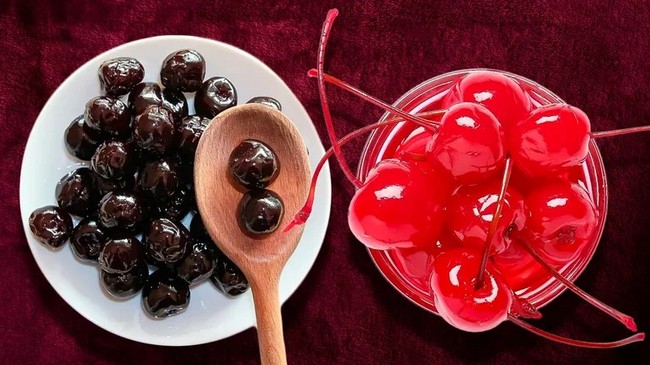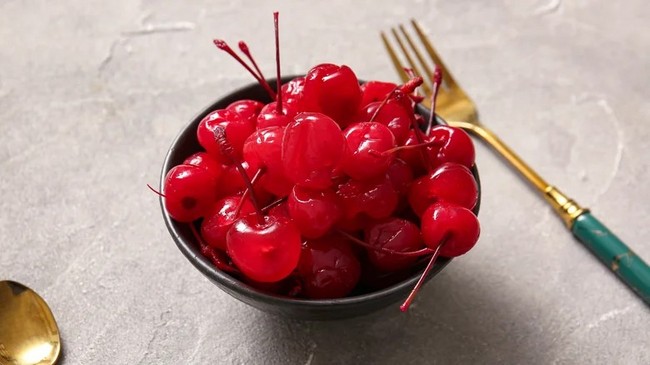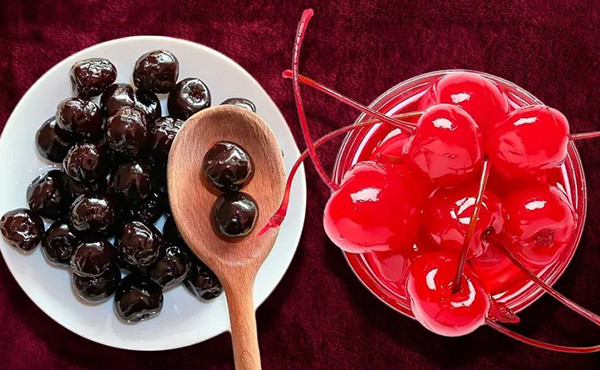✕

Column: industry Tag: amarena,maraschino,cherry Published: 2024-10-31 14:36 Source: www.mashed.com Author: STACIE ADAMSOCT

Static Media / Shutterstock
Edible cocktail garnishes enhance the look of a drink while also giving imbibers something tasty to eat. Cherries can be found embellishing many drinks including amaretto sours and Manhattans. Although maraschino cherries are often considered the go-to garnish, Amarena cherries are surging in popularity as the preferred garnish for more refined tastes.
While Amarena refers to a specific type of cherry, maraschino actually describes a multi-step process that results in the bright red cherries we all know and love. In addition to cocktails, this sweet, candy-like fruit preparation can also be used in cookies, cakes, and ice cream. In the past, marasca cherries were the preferred option for making maraschino cherries. These days, maraschino cherries are often made with Royal Ann or Rainier varieties.
Most types of maraschino cherries have an intensely sweet flavor that can be likened to candy, while Amarena cherries balance their sweetness with their natural tanginess for a more multi-faceted flavor profile. Unlike brandied cherry recipes, maraschino and Amarena cherries don't usually contain alcohol, at least not when you're picking up a jar from the store these days.
The interesting evolution of maraschino cherries

Pixel-Shot/Shutterstock
The first step in the maraschino cherry process involves soaking cherries in a brine. Historically, the brine was a combination of salt and water, but modern maraschino cherry brine includes calcium chloride and sulfur dioxide. These two chemicals essentially bleach the cherries, removing their existing color and flavor. To achieve the vibrant coloring and sweet taste synonymous with maraschino cherries, the fruit is then submerged in a mixture of almond oil, sugar, and red dye. Together, the two processes take between two months and 10 weeks, at which point the cherries can be bottled in a sweet syrup.
The Italian mascara cherries originally used to create maraschino cherries can also be distilled to concoct a cherry-flavored liqueur of the same name. In fact, maraschino liqueur was instrumental in importing and exporting the cherries thanks to its preservation capabilities. Boozy maraschino cherries were extremely popular in the U.S. until prohibition made the production of the liqueur illegal.
A professor at Oregon State University named Ernest H. Wiegand developed a preservation method in the 1930s that maintained the quality of the fruit. His method, which involved the use of calcium salts in brining solutions, helped American-made maraschino cherries match the quality of those imported from Italy and gave us the maraschino cherries we know today.
Amarena cherries: maraschino's sophisticated cousin

Digivic/Shutterstock
Among the many varieties of cherries (each with unique characteristics), Amarena cherries receive high praise for their indulgent flavor. They often come packaged in syrup similar to maraschino cherries (just without the brining and bleaching step), making them a great option for garnishing cocktails. The popularization of these cherries is often credited to Gennaro Fabbri, an Italian shop owner who added the dark, tart cherries in liquor into his product line in the 1930s. The company founded by Fabbri still produces Amarena cherries and even offers alternate recipes alongside the traditional product.
These days, Amarena cherries are typically processed without the use of liquor. Instead, they're steeped in sugar, water, and citric acid, which is a common preservative for jarred fruit. Additionally, Amarena cherries have a more complex flavor and a deeper, darker color than bright red, artificially flavored maraschino cherries. While maraschino cherries are most notable for their overwhelming sweetness, Amarena varieties feature subtle sour notes that make for a more interesting flavor. In addition to popping up in many cocktails, Amarena cherries can also be incorporated into baked goods or used to top yogurt. Thanks to their flavor complexity, they can even be added to many savory dishes, such as quiches and salads.
Previous:You Can Still Drink Ulysses S Grant's (Alleged) Favorite Bourbon Today
Next:Costco Decks The Halls Early With The Return Of Its Wine Advent Calendar
Hot key words
Hot Products
Popular Vendors